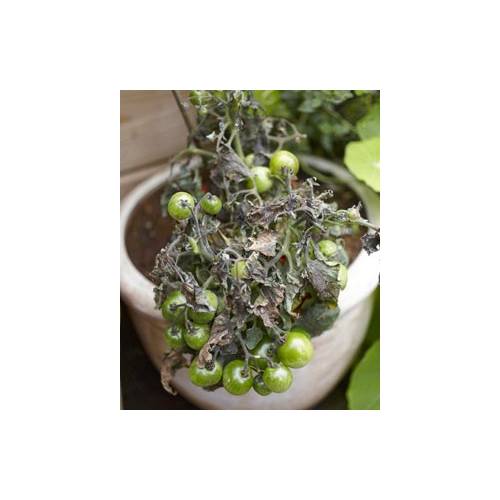
Fungus
Mildew
- Details
-
It is your tomato’s number one enemy! Mildew is a tough disease, that attacks many other plants, and its symptoms can be confused with those of other diseases.
The symptoms
The first sign of an attack is the apparition of small brown spots on the leaves or the stems. Progressively, the spots get bigger and the organs attacked start to wither. Mildew is seen on the leaves but also on the stems and fruits when forming.
Life cycle
Mildew is a fungus, which is present as a microscopic germ in the soil. It is the battering of the rain on the earth, which makes them bounce up on to the lower leaves of the plant. There, the germs start their activity and attack directly the plant cells, provoking the apparition of the first spots. Then the fungus filaments develop leading to a spreading of the disease. For mildew to develop, it needs precise conditions of temperature and humidity. Below 10° C or above 28°C, the fungus is inactive. Even if the temperature is right, it cannot develop if the air is dry.
How to fight mildew
Mildew is a pathogenic fungus, which is as a rule, sensitive to derivatives of sulphur and copper, such as the bouillie bordelaise solution. To be efficient, a treatment against mildew needs to be done before its apparition (as a preventative measure). Nevertheless, a treatment like spraying soluble sulphur is efficient when the temperature is hot (at least 20°C). Mildew is not sensitive to treatments based on vegetal extracts (liquid manure of horsetail or liquid manure of nettles), as it is an extremely virulent fungus. Vegetal extracts can only be used to limit the infestation; anyway, the black stains will not disappear.
How to avoid mildew
Good methods of cultivation limit the risks of attacks from mildew. For plants susceptible to mildew, one must ensure that they do not receive too much rain during the season. Therefore, the best method to avoid mildew attacks on tomatoes consists of growing them under cover such as an awning or tunnel, thus preventing rain from falling directly onto them. Choosing to grow varieties, which are naturally resistant to diseases, is also a good answer. On other plants, a few good acts delay the apparition of mildew:
- remove the leaves that are in direct contact with the ground,
- improve the air circulation around the cultivations,
- do not grow the same vegetables, in the same spot year after year,
- do not grow plants susceptible to mildew side by side, but on the contrary try to "spread them" in between plants not susceptible to it.
The well known plants which keep diseases at bay (garlic, sage, thyme, mugwort...) are absolutely useless against mildew, as are other "tricks" nevertheless widespread (egg shells suspended in the plants, copper threads winded up around the stem, etc.).
Good to know
This disease is a lot more virulent nowadays than it was fifty years ago. What has caused the problem is the systematic use of pesticides during the last half-century, which has encouraged the emergence of new strains that resist chemical treatments, and this is very unfortunate for gardeners! - Photos (1)

